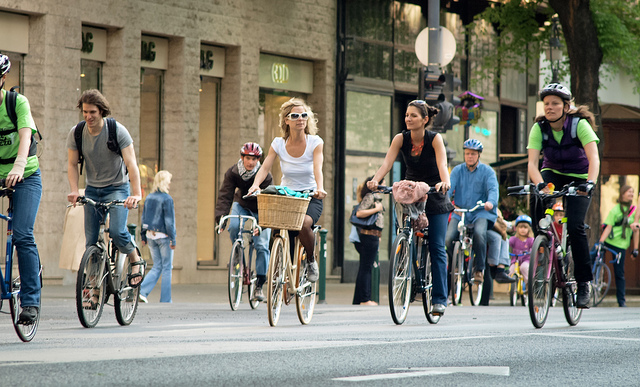
Huge cycle boom in Budapest
Cycling has increased elevenfold in Budapest in the past 20 years, especially the inner areas of the Hungarian capital experienced strong growth. More and more people bike not just during spring, summer time but throughout the whole year and the new public bike-sharing system is also getting visible in cycle traffic. Cycling emerged as a civil right in the city but progressive bike-friendly developments could help to grow the number of bikers.
Cycling is booming in Budapest. The number of bikers in the inner districts of the Hungarian capital grew elevenfold in the past 20 years according to a cycling traffic study conducted by Főmterv and Centre for Budapest Transport (BKK). In the inner areas of the city there were places where almost 1,2 million bike rides were recorded in 2014 - in both directions - and there were streets where cycling modal share reached 12 percent. BKK's aim is to raise cycling modal share to 10 percent by 2030, corresponding to previous plans.
The traffic study confirms that there are less and less people putting down their bikes during winter time and because of the warmer March in 2014 the biking boom started earlier. It is also clear from the traffic data that the number of weekday cycling has utterly overcome weekend cyclings. The usual length of a cycle ride is 5 kilometres and 90 percent of the rides were under 10 kilometres in 2014.
Two third of bikers cycle to work, bike-sharing on the rise
The study also summarised the results of a survey conducted with bikers in Budapest. More than ⅔ of cyclers use the bike to go to work, 44 percent of them use the bike daily and independently from weather conditions - another 37 percent use the bike daily, but depending on the weather. Almost ⅔ of cyclers in Budapest bike because it is a faster mode of transportation and healthier, whereas 23 percent ticked lower costs as a factor for cycling.
The study also tried to measure the usage of MOL Bubi - Budapest’s new public bike-sharing system launched autumn 2014 - bikes in the city. In the inner areas of the city 4-6 percent of the bikes were MOL Bubi-bikes (directly after the launch of the system), those areas have the biggest share of these cycles where there is a metro connection or it is next to a busy cycle path.
It should be also noted that according to the study despite the continued growth in the number of cyclers, accidents per unit of bikers are falling.
It all started with Critical Mass
The growth could be observed primarily in Budapest and looking at the yearly data parallels could be drawn with the huge cycling boom which started with Critical Mass, said Aron Halasz, communications officer of Magyar Kerékpárosklub (MK), the Hungarian Cyclists’ Club. Critical Mass, which was first organized in Budapest in 2004, kicked off the growth but later on more campaigns - like Bike2Work and Cyclechic - could have helped. However the whole process became self-generating, the good example ‘jumped’ from relative to relative, from friend to friend.
The majority of the media also became supportive after a time, celebrities gave their names to cycling - this might have also contributed to the growth. Cycling emerged as a civil right, biking has become a natural transportation tool even for those people who 10 years ago were not even thinking of cycling.
The communications officer of MK said, it is obvious that only comitted, progressive bike-friendly developments could help to increase cycling numbers. Developments have started but they are going at a moderate speed: ⅔ of the developments promised for the launch of MOL Bubi did not materialize so far. There are other problems too from the accessibility of the bridges over the Danube to the conversion, reconstruction of older bicycle paths in poor conditions.
About the author
 Gergely Nagy works as a Communications Intern at ECF, he takes care of ecf.com pages, databases and is involved in several advocacy topics.
Gergely Nagy works as a Communications Intern at ECF, he takes care of ecf.com pages, databases and is involved in several advocacy topics.
Regions:
Network/Project Involved:
- Log in to post comments
Contact the author
Recent news!
Upcoming events
Contact Us
Avenue des Arts, 7-8
Postal address: Rue de la Charité, 22
1210 Brussels, Belgium









